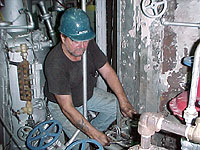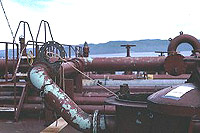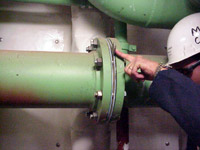Performing work on machinery and piping systems
present in the shipyard may expose workers to injuries due to
unanticipated machinery movement or release of materials (such as water, steam, oil). These systems may include:
Proper precautions, including blanking and securing machinery and piping, must be taken to prevent
injuries. [1915.163(a)]
Note: Confined space entry is one of the leading
hazards associated with barge cleaning. Review the
Ship Repair: Confined/Enclosed Spaces and Other Dangerous Atmospheres
chapter for information on how to protect workers from this hazard.
|
Boilers |
Potential Hazards:
Workers injured (for example, burned) from the exposure to:
- High-temperature
steam, water, or oil, which may enter the work area from an interconnecting
system.
- Explosion of hydrogen gas, which may be generated
during acid cleaning processes. See Fire and Explosion Hazards under the
Cleaning Operations page.
Requirements and Example Solutions:
-
Working in a dead boiler while the
adjacent boiler is live requires the piping and valves between the
boilers to be isolated by securing, blanking and tagging. [1915.162(a)(1)]
- Tags must not be removed nor the valves unblanked
until the work is completed. [1915.162(a)(1)]
- Where valves are welded instead of
bolted, at least two isolation and shutoff valves connecting the
dead boiler with the live system or systems must be secured,
locked, and tagged. [1915.162(a)(1)]
-
Drains must be opened and drainage visually verified. [1915.162(a)(2)]
-
A warning sign indicating workers are in boilers must be
conspicuously posted in the engine room (for example, near all boiler controls).
[1915.162(a)(3)]
Note: Control of Hazardous Energy Sources (Lockout/Tagout)
standard [1910.147],
does not apply to Ship Repair. |

Figure 1: Boilermaker working on boiler piping system.

Figure 2: Acid from acid tank can cause flammable gases when used for cleaning boilers.

Figure 3: Valves near dead boiler closed and tagged during work. |
 Back to Top
Back to Top |
|
|
Piping System |
Potential Hazards:
Workers injured (for example, burned) from the exposure to:
- High temperature steam, water, or oil, which may enter the work area from the piping system
(such as high or low-pressure steam, heating coils, thermal coils).
- Explosion of hydrogen gas, which may be generated during
cleaning of boilers. See Fire and Explosion Hazards under the Cleaning
Operations page.
Requirements and Example Solutions:
- Working on dead
systems that are connected to live systems requires the piping and
valves between the systems to be isolated by securing, blanking, and
tagging. [1915.163(a)(1)]
- Tags must not be removed nor the valves unblanked
until the work is completed. [1915.163(a)(1)]
- Where valves are welded instead of
bolted, at least two isolation and shutoff valves connecting the dead
system with the live system or systems must be secured,
locked, and tagged. [1915.163(a)(1)]
-
Drains must be opened and drainage visually verified. [1915.163(a)(2)]
Note: Control of Hazardous Energy Sources (Lockout/Tagout)
standard [1910.147],
does not apply to Shipyard Employment. |

Figure 4: Steam, air, water lines and valves present hazards when worked on.

Figure 5: Inert gas piping system isolated by blanking.

Figure 6: Blank in piping system verified in place by Certified Marine Chemist. |
 Back
to Top
Back
to Top
|
|
|
Propulsion Machinery |
Potential Hazards:
Workers may be injured by being struck by, caught in, or caught between
machinery and other objects (such as tail and intermediate shafts, propellers, gears).
Requirements and Example Solutions:
Before turning over the engine or
rotating the shaft and propeller:
- Jacking gear (jacking engine) must be engaged to prevent the
main engine from turning over, and signs must be posted at
the throttle. [1915.164(a)(1)]
- Stop valves on steam-driven jacking gear (jacking engine) must be secured, locked, and tagged.
[1915.164(a)(2)]
- The circuits controlling electrically driven jacking gear (jacking
engine) must be de-energized by removing the fuse or opening the
breaker or switch. The breaker, switch or fuse location must be
tagged. [1915.164(a)(3)]
-
Checks must be made to ensure that all workers,
equipment, and tools are clear of the engine, reduction
gear, connecting accessories, and propeller. [1915.164(b) and
(d)]
-
A warning sign indicating work is being conducted on or around the
propeller must be
conspicuously posted in the engine room. [1915.164(c)]
Note: Control of Hazardous Energy Sources
(Lockout/Tagout)
standard [1910.147],
does not apply to Shipyard Employment.
 Back to Top
Back to Top
|

Figure 7: Workers installing/removing main shaft gear.

Figure 8 Thrust bearing and shaft guarded and clear of workers. |
|
|
Deck Machinery
|
Potential Hazards:
Workers may be injured by being struck by, caught in, or caught between by the
sudden movement of anchor chains or windlass.
Requirements and Example Solutions:
Before working on the anchor windlass (for
example, an anchor winch) or
any of its attached accessories (e.g., cables, chains) ensure: [1915.165(a)]
-
Devil claws must be secured to the anchor chains to prevent the
anchor from falling. [1915.165(a)(1)]
-
Riding pawls (such as dogs) must be engaged to prevent rotation of
the windlass. [1915.165(a)(2)]
-
When devil claws and riding pawls are absent, anchor chains must be secured
to the vessel. [1915.165(a)(3)]
Note: Control of Hazardous Energy Sources (Lockout/Tagout)
standard [1910.147],
does not apply to Shipyard Employment.
|

Figure 9: Movement of anchor windlass and chain can present crushing hazards.

Figure 10: Winch and cathead can present "caught in" hazard.

Figure 11: Anchor chain secured by wire cables (instead of devil claws) to prevent the anchor from falling. |
 Back
to Top
Back
to Top |
|
|

